Studio blog
News and updates about Tom Phillips, posted by the artist himself
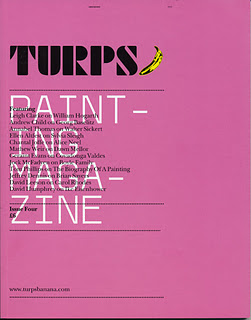
Out today, Issue 4 of the highly recommended Turps Banana painting magazine includes amongst other features Tom Phillips' Biography Of A Painting I.
To subscribe follow this link.
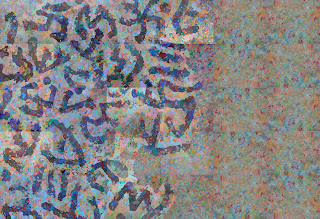
Having now found the off switch to the spooky illusion of colour stratified in space (though still indulging in the occasional vivid trance of depth) I return to other anxieties, especially to do with how the painting itself has taken over in a different way.
Just as the novelist reaches a certain point where his characters, empowered by a sudden and mysterious accession of free will, begin to act and speak for themselves and to contradict their creator’s intentions, so the artist is surprised when the shapes and colours and configurations of elements in his painting start to clamour for a similar autonomy. They argue with the painter and amongst themselves. The artist who started as captain becomes an umpire as well.
The last thing I do every night is look in the studio to inspect the day’s work, and think about the general state of play. Also, unbreakfasted and teeth as yet unbrushed, it is the first thing I do each morning. I like to see whether, say, yesterday’s radical gesture has been absorbed by the image as a whole. It is a constant of infanthood to imagine one's toys and dolls having a communal life of talk and action when their owner sleeps. So with that same infant optimism I look to see if any problems have been resolved while my eyes were shut.
This can also prove be the Frankenstein moment when a picture that one left in apparent calm seems to have had a bad night and groans its dissatisfaction at recent changes.
As I move eastward across the surface I realise that new manoeuvres affect the mood of previous work and at the moment all is distinctly unquiet on the Western Front. Certain marks are pressing for revision, for a second chance. While one begs for fusion with a neighbouring element another is suing for divorce from its present partnering.
Making such sorties backwards in the picture to dress a wound or reset a bone has its own peculiarity. I find that although the language of the picture is consistent, the past has a slightly different dialect. This was especially true when remaking the initial panel in the image’s far North West territory. In terms of colour alone, I found in that region that I did not have (almost a year ago) on my palette the prussian side of the blue scale but was rooting cool areas in ultramarine alone. Thus I had the choice of readopting the old colour dialect or infiltrating (as if on a modest time machine) news from the future. I chose the latter course.
But at least I am still in charge. However, I know from experience that a moment will come (months away as yet) when the work banishes its creator. In the end it is the painting that declares itself finished.
The artist does not necessarily know when the mark he has just made is the last. He will enter the studio one morning and find, almost with brush poised, that the picture is as out of bounds as a taped-off crime scene.
It must then be accepted WAF as the book dealers’ catalogues say, with all faults. If the artist wants to improve things his only option is to do so with another painting.
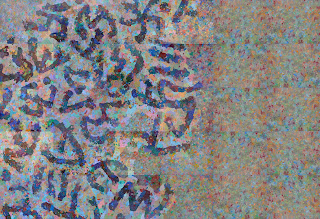
(Seated one day at the easel…)
Something strange has occurred with the painting, unique in my experience.
As in the chilling stories of M R James this account begins prosaically…
I am in my studio chair with the winter light about to fade. It is teatime and I look across to my painting arrayed on the wall, hoping to identify some progress. A sudden shaft of lemony light illuminates the centre of the picture giving its colours new vivacity.
Concentrating on that troublesome area where much has yet to be resolved and where an indecisive hole of underpainting is still exposed. I notice with surprise that the surrounding tracery of paint seems to quiver as if trying to detach itself from the surface of the panel. A cloud passes and the effect disappears but after a few minutes, in another glare of low sunlight, it reasserts itself. I can now unequivocally experience parts of the picture lifted, as if on another plane, free of the mostly subdued colours of the random underpainting. As the light fades to evening greyness so the perturbation ceases, and when I switch on the electric light all returns to a fixed normality.
The following morning painting proceeds as usual. Returning from lunch however I find the studio more intensely lit, and soon, as if raising a spirit, I can begin to lift a layer of overpainting into the thin air above the surface of the panels in that same area. This now floats an apparent inch or so in space in front of the rest of the paint. I discover also that this is not a merely local phenomenon but one that can be summoned over the whole area though initially most apparent where the underpainting has been left alone. While the light holds I acquire the knack of switching the apparition on and off.
The next day I am disappointed (and also almost relieved) not to see parts of the painting floating free. But once more, after lunch the light becomes denser and the coloured veil begins to lift unbidden. Now with more constant illumination from a clear sky I find a second layer and then a third projected one in front of the other occupying a conjectured three inches or so.
In essence this follows the rules of recessive and foregrounding colours that one learns at art school, with red things looking nearer and blue things further away etc. My Euston Road training with Euan Uglow and others still conditions me to think of a London Bus as turning lilac by degrees as it drives into the distance.
Here the colours do not follow the rule strictly: some reds hang back and some blues reach forward. Lightness and darkness also play their roles in relative position.
Still gripped by the novelty of the experience I wander mentally between the layers and find I can separate at least five of them out, the nearest of which now feels to be six inches or so in front of the panels. This front layer is sparsely occupied by otherwise homeless bright spots some of which travel through from the distant underpainting.
In the days that follow I both savour and resent the illusion for now I do not need, so to speak, to make any effort to have lift-off; it is always there and distractingly magical.
The phantom dimensions that are engendered and, with each looking, become more clear are not part of a rounded world but like theatre flats, or rather gauzes since they have no solidity. The nearest analogy is the world as presented by those stereoscopic photographs seen through a viewer which were so popular in the early days of photography. A great illusion of depth is produced but only in terms of receding two dimensional layers whereby papery people stand in front of wafer-thin houses against a background of flat trees.
The only difference here is that, in an abstraction, these divisions are only made of colour with no objective identity. Thus I peer through brane beyond insubstantial brane of patterning in which the colours have lost the physicality of pigment. They merely seem suspended in the air unattached to anything but the imagined plane which they inhabit (and which cannot itself in any way be seen).
I certainly had no such goal in mind when I started the work and do not see it as necessarily adding quality to the image. It is merely an epiphenomenon of the way in which the picture is made, however beautiful it is to experience as it grows in depth and complexity.
In a real M R James story, or a tale by Edgar Allen Poe, the layers would of course continue to advance across the studio until I became snared in their intricate webs and entrapped by the thing I had created……. if, therefore, this account suddenly peters out and there are no more entries you will know what has happened.
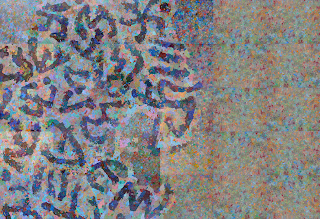
Late February 2008
When I supplied a version of this commentary as Episode I of a contribution to Turps magazine [www.turpsbanana.com or coming soon to your nearest esoteric outlet] I appended, in place of the hoped for cliff-hanger, the following dry account of such technical data as a professional journal might expect...
Technical Notes
Technically there are no mysteries. The fabrication is simple and the means austere. Andy has now provided me with panels for the whole work based on the one I started with (now replaced). The surface of each is 3.2mm untempered hardboard braced by pine battens 27mm x 27mm glued on with Titebond (aliphatic resin wood adhesive). They are primed with Golden Acrylic white primer toned down with Mars Black (Tri Art). The primer has been given some ‘tooth’ by the addition of pumice (grade 250 grit) which also makes for a more matte surface. Proportion is approx one teaspoonful to a litre of primer, which is applied in 4 or 5 coats with 24hr hardening time between each application. The final surface is then lightly sanded with 400 grit wet and dry paper (silicon carbide) used dry.
Each panel is underpainted with an all over, hastily brushed, random field of muted colour with mid-tones predominating and the occasional accent of purer hues amongst the general diffuseness. This is what happened with the second panel I started and became the general practise, though not too much effort is made to achieve the same effect with each.
As for the oil paint itself I now tend to use Michael Harding’s rich pigments for the most part though I retain old favourites from Winsor & Newton’s range, notably the pungent Winsor Green and the potent Winsor Violet. There are of course other tubes occasionally brought into play variously bought at various times, some as long as thirty years ago, including a seemingly inexhaustible tube of Indian Red from Spectrum, a relic of art school days. I don’t use any fancy driers or extra mediums, relying on white spirit. Only in the world of art mags is there no substitute for turps.
For the underpainting I’m happy to use any medium size brush that comes to hand. The delicate tracery and detailed patterning that rapidly became the norm of the second stage called for small fine brushes that would retain their point and have the necessary spring. In my schoolboy days this would have evoked the hushed mention of Kolinsky Sable. One knew that for really fine painting only this treasured hair, gathered from rare and rufous rodents in the Steppes of central Asia, would do. This is a myth, or has become one. I have tried the ever improving range of artificial fibres which started a generation ago with very floppy nylon but now firm mixtures of hair are used, which keep their spring and shape after repeated use and only need a brisk rinse in white spirit at the end of the day. Prolene (Pro-Arte) and Cotman (Winsor & Newton) are excellent in small sizes but I have a slight preference for Sablette made by Utrecht, which I found in the shop opposite the Chelsea Hotel. In all the surface painting so far I have used up no more than three such size 1 brushes. No weasel fears my easel: let mustela sibirica scamper free.
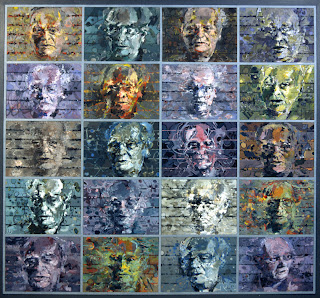
Portrait of Olivier Messiaen, acrylic on panel, 1993
For any who might have listened to Iain Burnside's Radio 3 programme on Sunday 24th February here is the portrait (Vingt Regards) that I did of Olivier Messiaen for the French National Collection. This was the subject of my long rambling anecdote.
On Sunday 24th February, Tom Phillips will be joining Iain Burnside on his Sunday morning show on BBC Radio 3, playing amongst other things, the studio tape of Brian Eno's Like Running Away. The two hour programme begins at 10am. For further information follow this link where you can listen again for seven days after broadcast.
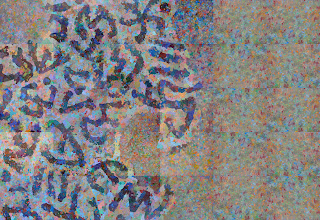
It is Dante time in the enterprise, nel mezzo del cammin… just half way through the journey… on what is getting to be a bumpy road judging from the bulge of chaos in the centre, plus the many elements still unresolved; and a beginning panel yet to be fully reworked.
Nevertheless it seems a natural break in the story, like the interval in a two act opera when the plot is known and the aesthetic established even if the outcome is only to be guessed at. Whatever the case Vincero! Vinc-e-ero! seems a long way off.
It would be a strange opera however that, by the time the audience sought bars and lavatories or the ever shrinking smoker’s ghetto, had not announced its title. I am still somehow left with Untitled: A Fragment which is neither resonant, inviting nor informative, and which begs the question, “What’s it all about then, guv?” This question properly dogs my working day where every certainty has its corresponding doubt and in which the only absolute certainty is doubt itself. On the other hand it is axiomatic of abstract art that it strives to be non-referential and thus it is an appropriate and primary aim of this picture that it should be an autonomous act of painting.
However the difficulty of finding a title is caused more by a multiplicity rather than a paucity of allusion; though allusion is not quite the right word. Dante says that his Comedy (it was not he that called it Divine) in terms of its meaning is polysemous, a many layered thing. My picture avoids his particularity of meaning and its visual dialectic might better be described as polyanalogical. Passing through it there are ghosts of many kinds of enquiry and activity from cosmology to tattooing. These include, among others, mapmaking, dance, territorial board games, quantum physics, ping pong, calligraphy, topology, semiotics, form and growth in nature and the mark-making of early man. Of some I have little understanding (quantum physics) or am a lowly practitioner (ping pong) but there is one more familiar parallel world whose totality, as well as its parts (pitch, key, tonal spectrum, rhythms, form and dynamic), proves a constant model for much of what I do, and that is music.
Yet the upper stratum of my thought when working, or just staring dumbly wondering how to go on, is purely pictorial. The picture, by alluding to no thing specifically, remains for me a permeable structure which associations can enter freely, visit and leave, or stay and inhabit.
My goal is that those who see it will find it equally porous, and, remembering the girl heroine of Eleanora H. Porter’s popular novel, Pollyanna, will relish the ‘glad game’ I hope to make (which makes me think that polyanalogical was not such a bad word).
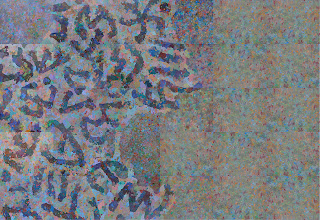
Here Alice has cooked up, by the addition of underpainting yet unmade, a composite image which shows more clearly how the picture is going. This is in preparation for an article in Turps magazine which will be a digest of this blog as Part I of a gripping two part series. The next entry here will make the half time summary.
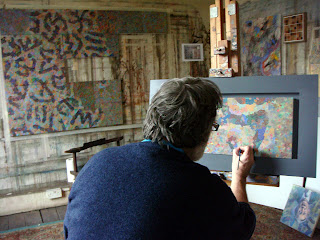
After observing my maladroit fidgeting with clamps to hold any two panels together on the easel Andy suggested making a simple holder, here in use, which does the trick... with the additional benefit of giving the hand a less risky resting place than on the picture surface.

The Tom Phillips postcard exhibition Anonymous Celebrities, currently at the Williamson Art Gallery in Birkenhead, closes next weekend. Final admission is at 1600 on Sunday 17th February. Here is Tom Phillips with Patrick Wildgust the curator of Shandy Hall, who chaired an informal discussion with the artist before an invited audience on the opening night.
Archives
- 2023
- June (2)
- May (1)
- 2022
- October (1)
- September (1)
- July (1)
- June (1)
- 2021
- September (1)
- July (1)
- May (2)
- April (1)
- March (1)
- 2020
- December (1)
